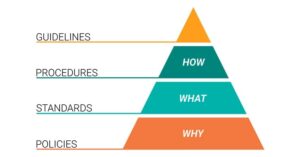Google provides content guidelines to help webmasters and content creators create content that is useful and valuable for users. With Google being a clear market leader in search engines segment, following these guidelines will obviously improve your website’s visibility and ranking in Google search results.

Google’s helpful content update lays emphasis on avoiding creating content for search engines first. Goggle Search Central Blog has summarized it as follows:
“The helpful content update aims to better reward content where visitors feel they’ve had a satisfying experience, while content that doesn’t meet a visitor’s expectations won’t perform as well.”
The latest update (Google Helpful Content Update of 2023) aims to provide better information, satisfy user intent, and connect people with interesting, rich content written for humans.
The new update is a reminder to content creators that SEO checklist should only come second to satisfying the readers.
Understand the evolution of Google’s content guidelines

The evolution and significance of Google’s content guidelines are closely tied to the search engine’s mission to provide users with high-quality, relevant, and trustworthy information (Read EAT principles).
Google’s content guidelines have evolved (Google Algorithm updates) over the years to address the changing landscape of the internet, improve the quality of search results, and combat various forms of web malpractices and low-quality content.
Importance of Google’s Content Guidelines
The general direction of Google content guidelines is to present the internet users with credible content, user experience and solutions to their problems. This is achieved in the following ways:
- Quality Search Results – Google’s content guidelines are critical for delivering high-quality search results to users. By promoting valuable and trustworthy content, Google helps users find the information they need quickly and accurately.
- professionally Designed Websites – High-quality content guidelines improve the user experience by ensuring that websites are well-structured and easily navigable.
- Combatting Spam – The guidelines help Google identify and penalise spammy and low-quality websites, thereby discouraging manipulative practices and rewarding genuine, informative content creators.
- Trust and Authority – principles such as E-A-T promote trust and authority, especially for content that can impact users’ well-being and financial decisions (Read Your Money or Your Life-YMYL). Users can rely on Google to provide accurate and authoritative information.
- Mobile and Accessibility – Emphasis on mobile-friendliness and accessibility is a guarantee that websites are accessible to a wide range of users, including those with disabilities and those on mobile devices.
- Secure Browsing –The preference for HTTPS is an assurance that users’ data and interactions with websites are secure, contributing to a safer internet experience.
- Transparency – By insisting of clear contact information of the website, citing where applicable and disclosure of sponsored content, the guidelines aims to foster trust between websites and their users.
The Google content guidelines are important not only for search engine optimisation but also for creating a better online experience for users, promoting trustworthy and authoritative information on the web.
Emerging Trends in Google’s 2023 Helpful Content Update
According to Google Search Central,
The Google Helpful Content System aims to better reward content where visitors feel they’ve had a satisfying experience, while content that doesn’t meet a visitor’s expectations won’t perform as well.The system generates a site-wide signal that we consider among many other signals for use in Google Search (which includes Discover). The system automatically identifies content that seems to have little value, low-added value or is otherwise not particularly helpful to people.Any content—not just unhelpful content—on sites determined to have relatively high amounts of unhelpful content overall is less likely to perform well in Search, assuming there is other content elsewhere from the web that’s better to display. For this reason, removing unhelpful content could help the rankings of your other content.
Its therefore clear that Google’s Helpful Content System works in conjunction with other signals to rank websites based on the quality and usefulness of their content.
The Goole’s September 2023 update lay focus on the following three key changes to the Helpful Content System’s guidelines:
- AI-generated content
- Third-arty hosted content hosted on primary or sub domain
- Advisory on traffic loss following the update
AI-generated content

AI content creation tools have increasingly becoming popular in the recent past for various reasons. In particular, businesses have benefited immensely in creation of high-quality content more quickly and efficiently .
AI writing assistants such as ChatGPT are now a household name in all blogospheres. In its earlier release of content guidelines, Google seemed to be too harsh on auto-generated content. The perception was that Google had preferred human-produced content to content produced by generative AI
However this seems to have changed in the latest helpful content update, perhaps in response to the tremendous improvement in the quality of the output of generative AI.
Google has the following to say in relation to AI generated content:
At Google, we’ve long believed in the power of AI to transform the ability to deliver helpful information. Our focus on the quality of content, rather than how content is produced, is a useful guide that has helped us deliver reliable, high quality results to users for years.
As long as AI-generated content is thoughtfully and ethically produced in tandem with human creativity and expertise, it will not be penalised by the Google helpful content update. Combining AI-generated content with human expertise and oversight can yield the best results in many applications.
Third-party content hosted on primary or sub domain
Hosting third-party content on your primary domain or subdomain can be a valuable strategy to enhance your website’s functionality or benefit the content in the subdomain with the primary domain authority. However it requires careful consideration of factors such as performance, security, user experience, and legal compliance.
In the latest Google helpful content update, Google appears to discourage the practice of third-party content hosting particularly if the content is unrelated to the main domain.
If you host third-party content on your main site or in your subdomains, understand that such content may be included in site-wide signals we generate, such as the helpfulness of content. For this reason, if that content is largely independent of the main site’s purpose or produced without close supervision or the involvement of the primary site, we recommend that it should be blocked from being indexed by Google
If you’re hosting third-arty content in your primary domain that has little or nothing to do with your website’s main purpose or content, your rankings might be affected.
Remember this ranking signal is weighted, implying that lots of unhelpful third-party content in your site will be detrimental to its ranking.
Advisory on traffic loss following the update
As a content creator, you have no choice but to learn and adhere to the Google’s Helpful Content updates so as to benefit your content. requires publishers to understand and align with Google’s definition of helpfulness.
Towards this end, Google has offered general guidance to help content creators self-assess whether they’re producing helpful content.
Some of the questions on content and quality in these guideline include:
Does the content provide original information, reporting, research, or analysis?Does the content provide a substantial, complete, or comprehensive description of the topic?Does the content provide insightful analysis or interesting information that is beyond the obvious?If the content draws on other sources, does it avoid simply copying or rewriting those sources, and instead provide substantial additional value and originality?
In articular, content creators should avoid fake freshness at all cost. Fake freshness include;
- changing the dates in your blogposts to make the content appear recent when there’s minimal or changes to the content.
- Adding substantial new content or removing a lot of old content to make your site appear fresh.
If your content is helpful, you need not worry about these updates. That is not to say that your existing content doesn’t require some review to make it genuinely fresh.
In summary Google advises as follows:
- Review Google’s self-assessment on helpful content.
- Identify, remove or replace unhelpful content.
- Make use of an expert or authority in the subject to review your content
- Invest in new, better content creation techniques.
| 7 Ways to Build and Improve EAT |
Strategies for The User-Centric Content
Writing with a user-centric approach means creating content that prioritises the needs, preferences, and expectations of your audience. Whether you’re crafting blog posts, website copy, marketing materials, or any other form of content, keeping the user in mind is essential for engaging, informing, and satisfying your audience.
Here are some key principles and strategies for writing with a user-centric approach:
Know and understand your audience
 At the point when you choose a niche, you already know who your target audience is. It’s important to develop their persona – demographics, interests, pain points, goals, language etc.
At the point when you choose a niche, you already know who your target audience is. It’s important to develop their persona – demographics, interests, pain points, goals, language etc.
Conduct market research regularly to adapt to the changing landscape.
Read how to know your audience better
Address their needs and questions
platforms such Google Analytics will help you identify the questions, problems, or challenges your audience is facing. Create content that directly addresses these issues, offering practical solutions and guidance. Your focus should be on providing value in every piece of content you create. Inform, educate, entertain, or inspire your audience
Engage and capture attention
The idea is to make your content be as engaging as possible. Compelling headlines and introductions help to capture readers’ attention. Use storytelling, anecdotes, or thought-provoking questions to make your content more engaging.
Organise content effectively

A well written and clear out is the first point of attraction to the reader. Use clear headings, subheadings, and bullet points to improve clarity. Organise your information logically, with a clear structure and flow.
Visual elements and multimedia
Visuals, such as images, infographics, and videos enhance understanding and engagement.
Personalisation
Where applicable, tailor your content to individual preferences. This can include personalised recommendations based on individual user behaviour. For example, if you are sending mass emails, free tools such as Convertkit can help you individualise the emails to all your readers.
Inclusivity
Your content should be inclusive and accessible to all users, including those with disabilities. Use alt text for images and provide transcripts for videos. This should also address the issue of mobile-friendliness.
Consistency and brand voice
Maintaining a consistent brand voice and tone in your content helps in building recognition and trust among your audience.
Encourage interaction & feedback

You should always offer your readers an orotundity to interact with your content by asking questions, prompting discussions, or including calls to action (CTAs) that guide them to the next steps. The feedback is key in improving your content and tailor it to the changing needs and preferences of your audience.
Respect privacy and originality
Your audience require assurance that their data and privacy is secure. Compliance with relevant data protection laws and best practices. plagiarised content is also a big turn off for many internet users.
User-centric approach to content creation is an ongoing process. Regularly reassess your audience’s needs and adjust your content strategy accordingly. By prioritizing your audience’s interests and well-being, you can build trust, foster engagement, and achieve your content marketing goals.
Summary
Google helpful content guidelines for AI-generated content and SEO lays emphasis on value and uniqueness. prior to this guidelines, Google technically treated AI-generated content as spam. With the guidelines, the focus is now experience, expertise, authoritativeness and trustworthiness (EEAT) criteria.
AI blogging assistants such as ChatGPT carry some inherent risk of plagiarism, copyright violations and subsquently search engines penalties. An absolute AI-generated content will often than not violate the Google helpful content guidelines.
Your E-E-A-T input into every blogpost you make is mandatory. Self-assess your content as er the Google guidelines as well as carry out SEO audit to existing content regularly for compliance. If you leave AI to reduce your content without your involvement, you can as well forget ranking.
Jeff
Safariaffiliate
